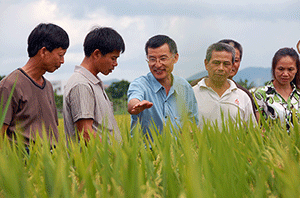Tag: fertilizer

Video: From Subsistence to Success for African Smallholder Farmers with Terje Tollefsen, Yara
Africa & Middle East: Ahead of the International Fertilizer Industry Association’s Annual Conference in Sydney next week, Farming First talks business with Terje Tollefsen, Head of Strategy and Business Development at Yara International ASA. Tollefsen highlights the efforts made by Yara in unlocking value chains in Africa. He points to the company’s work with Masara N’Arziki, which aims to increase […]
Read MoreRice Nutrition Management Pioneer Dr. Xuhua Zhong Wins IFA Norman Borlaug Award
Asia: The International Fertilizer Industry Association (IFA) has awarded crop physiologist Dr. Xuhua Zhong this year’s IFA Norman Borlaug Award for his achievements in rice nutrition management in China. Dr. Zhong, head of the Crop Physiology and Ecology Laboratory at the Guangdong Academy of Agricultural Sciences, developed the ‘three controls’ technology. The process incorporates control of nitrogen (N) input, control of […]
Read MoreDelivering agricultural inputs in Tanzania
Africa & Middle East: Almost seven years ago, the Tanzanian government approached fertilizer company Yara regarding a fertilizer partnership that would provide a stable supply of mineral fertilizers for the country’s farmers. Two years later, in 2006, the idea for the project expanded: realising that the real challenges extended beyond the supply of crop nutrients, the partnership needed to […]
Read MoreThe Ghana Grains Partnership
Africa & Middle East: Smallholder farmers in Ghana typically face several challenges preventing them from producing better yields. Among the lack of access to credit, inputs, storage facilities and infrastructure, a big influence on them is the belief that increasing production only serves to make the local market crash and prices plummet. Back in 2008, fertilizer company Yara initiated […]
Read MoreBuilding on the success of Malawi’s fertilizer subsidy programme
Africa & Middle East: Since its introduction in 2004, the Malawian government’s subsidy programme, which gives smallholders vouchers to buy seeds and fertilizer, has more than doubled farmers’ harvests. The example of Malawi is cited regularly as a symbol of how African agriculture can lift itself out of low productivity. In order to continue the programme’s success, in 2007 […]
Read MoreThe Southern Agricultural Growth Corridor of Tanzania
Africa & Middle East: With Dar es Salaam port providing access to the Indian Ocean for the interior of Tanzania and its neighbouring landlocked countries – Malawi, Zambia and the Congo, Tanzania has a large agricultural potential. The Southern Corridor, through serving both regional and international markets, could become a vibrant sustainable commercial farming sector, helping to enhance local food […]
Read MoreFilipino Farmers Given Fertilizer Advice Via Text Message
Asia: Rice farmers in the Philippines are being given advice on best fertilizer use through a new text message programme. The scheme, thought to be a worldwide first, has been launched by the International Rice Research Institute (IRRI) where scientists have spent 18 years refining a computerized system to advise farmers on optimal fertilizer use via […]
Read MoreFighting Iodine Deficiencies in China through Fertilizer and Irrigation
Asia: Iodine is an essential micronutrient to sustain human and animal health, yet it is one of the most common micronutrient deficiencies in malnutrition. Globally it is estimated that 2.2 billion people in the world are at a risk of iodine deficiency. Iodine deficiencies can cause a wide range of physiological abnormalities (Iodine Deficiency Disorders), mainly related […]
Read MoreCredit for Fertilizer Helps Peruvian Coffee Growers Improve Livelihoods
Latin America & the Caribbean: Coffee-growers in Peru have been receiving a helping hand from a homegrown programme that provides credit for purchasing fertilizer. The “Family Program”, which was set up by coffee exporter Comercio & Cia in 2003, has been giving farmers interest-free credit for three consecutive years, whose crop production is then sold back to Comercio & Cia […]
Read More

